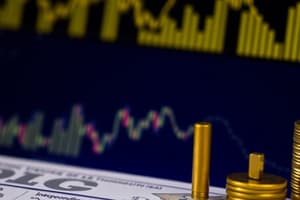Podcast
Questions and Answers
What is the main difference between a negative externality and a positive externality in the context of market failure?
What is the main difference between a negative externality and a positive externality in the context of market failure?
A negative externality is a third-party cost, while a positive externality is a third-party benefit.
What is the primary tool used by central banks to implement monetary policy, and how does it affect the money supply?
What is the primary tool used by central banks to implement monetary policy, and how does it affect the money supply?
The primary tool is the interest rate, which affects the money supply by influencing borrowing and spending.
What is the Laffer Curve, and how does it relate to supply-side policy?
What is the Laffer Curve, and how does it relate to supply-side policy?
The Laffer Curve shows the relationship between tax rates and revenue, suggesting that high tax rates can decrease revenue, and supply-side policy aims to increase revenue by reducing tax rates and encouraging economic growth.
What is the difference between the nominal and real exchange rate, and how do they affect international trade?
What is the difference between the nominal and real exchange rate, and how do they affect international trade?
What is the definition of a trade surplus, and how does it affect the balance of payments?
What is the definition of a trade surplus, and how does it affect the balance of payments?
Flashcards are hidden until you start studying
Study Notes
Market Failure
- Market failure occurs when the free market fails to allocate resources efficiently, leading to a misallocation of resources.
- Examples of market failure include:
- Externalities: positive or negative effects on third parties not involved in the market transaction (e.g., pollution).
- Public goods: goods that are non-rivalrous and non-excludable (e.g., national defense).
- Asymmetric information: unequal access to information between buyers and sellers.
Fiscal Policy
- Fiscal policy refers to the use of government spending and taxation to influence the overall level of economic activity.
- Expansionary fiscal policy: increasing government spending or reducing taxes to stimulate the economy.
- Contractionary fiscal policy: decreasing government spending or increasing taxes to slow down the economy.
Monetary Policy
- Monetary policy refers to the actions of central banks to control the money supply and interest rates to promote economic growth and stability.
- Monetary policy tools include:
- Open market operations: buying or selling government securities to increase or decrease the money supply.
- Changing reserve requirements: altering the percentage of deposits that commercial banks must hold in reserve.
- Setting interest rates: adjusting interest rates to influence borrowing and spending.
Supply-Side Policy
- Supply-side policy focuses on improving the productive capacity of the economy by encouraging investment, innovation, and entrepreneurship.
- Examples of supply-side policies include:
- Tax cuts to encourage entrepreneurship and investment.
- Deregulation to reduce bureaucratic barriers to business.
- Investment in education and training to enhance human capital.
Economic Growth
- Economic growth refers to an increase in the production of goods and services in an economy over time.
- Factors influencing economic growth include:
- Technological progress.
- Investment in human capital.
- Institutional factors (e.g., property rights, rule of law).
Unemployment
- Unemployment occurs when individuals are able and willing to work but are unable to find employment.
- Types of unemployment include:
- Frictional unemployment: temporary unemployment due to job searching or transitions.
- Structural unemployment: long-term unemployment due to changes in the economy (e.g., automation).
- Cyclical unemployment: unemployment due to fluctuations in the business cycle.
Inflation
- Inflation refers to a sustained increase in the general price level of goods and services in an economy over time.
- Causes of inflation include:
- Demand-pull inflation: excessive aggregate demand.
- Cost-push inflation: increases in production costs (e.g., wages, raw materials).
- Monetary policy: excessive money supply growth.
Globalisation
- Globalisation refers to the increasing integration of economies worldwide through trade, investment, and technological exchange.
- Benefits of globalisation include:
- Efficient allocation of resources.
- Increased economic growth.
- Job creation.
Free Trade
- Free trade refers to the absence of tariffs, quotas, and other trade barriers that restrict international trade.
- Advantages of free trade include:
- Increased efficiency and competitiveness.
- Wider range of goods and services available to consumers.
- Economic growth and job creation.
Protectionism
- Protectionism refers to government policies that restrict international trade to protect domestic industries.
- Examples of protectionist policies include:
- Tariffs: taxes on imported goods.
- Quotas: limits on the quantity of imported goods.
- Subsidies: financial support for domestic industries.
Exchange Rates and Balance of Payments
- Exchange rate: the price of one country's currency in terms of another country's currency.
- Balance of payments: a record of a country's international transactions, including trade, investment, and transfer payments.
- Components of the balance of payments include:
- Current account: trade in goods and services.
- Capital account: investment and financial transactions.
- Financial account: changes in foreign assets and liabilities.
Studying That Suits You
Use AI to generate personalized quizzes and flashcards to suit your learning preferences.




